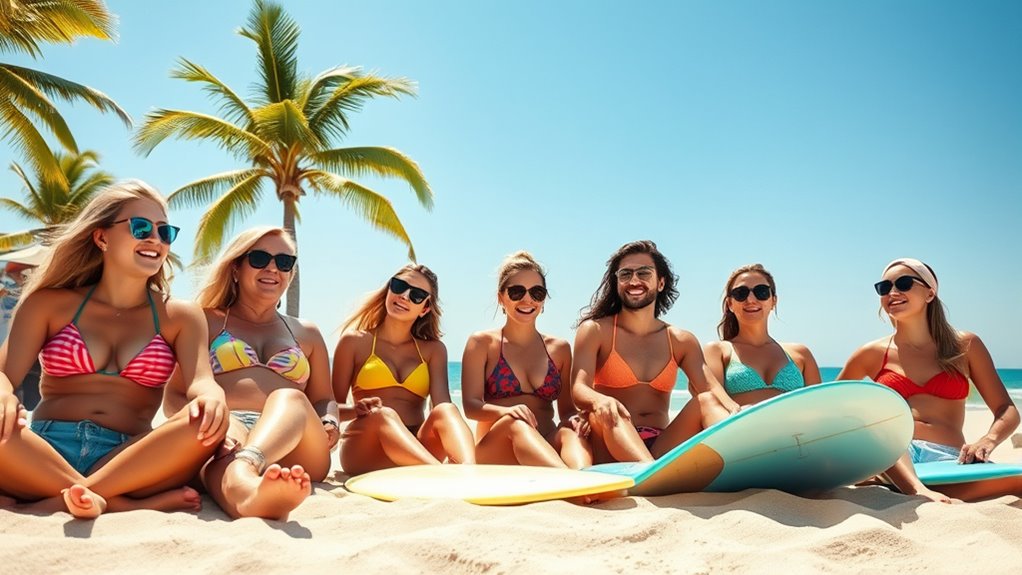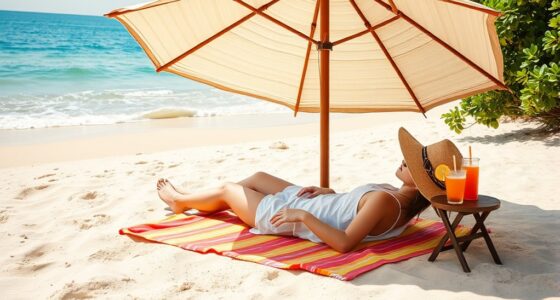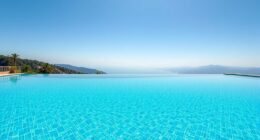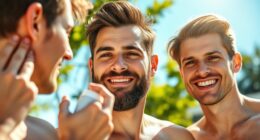During spring break, many people pursue tanning through outdoor sunbathing, indoor beds, or spray tans, driven by media and social norms linking a tan to attractiveness and health. However, these practices markedly increase your risk of skin cancer, premature aging, and eye damage. To stay safe, consider protective measures like sunscreen, clothing, and seeking shade, or try sunless tanning options. If you want to learn more about safer ways to enjoy spring break, keep exploring these tips.
Key Takeaways
- Outdoor tanning and indoor tanning beds are popular Spring Break activities, often driven by cultural standards and social influences.
- Tanning increases skin cancer risks, including melanoma, especially with frequent UV exposure during Spring Break.
- Using protective measures like sunscreen, protective clothing, and seeking shade can reduce skin damage risks.
- Sunless tanning options offer a safer, quick alternative to UV exposure, providing customizable results without health hazards.
- Mindful planning and awareness of UV index help limit harmful sun exposure during outdoor Spring Break activities.
Popular Tanning Practices Among College Students

Many college students actively engage in various tanning methods to achieve the desired look, with outdoor tanning being the most popular. You’ll often see students sunbathing at campus pools or outdoor spots, using oils to speed up the process. Indoor tanning beds are also common, especially near college housing, with over half of students trying this method at some point. Spray tanning, while less widespread, is still popular as a quicker, less UV-intensive option. Many students combine these methods—using indoor beds to top off outdoor tans or applying tanning oils outside. Tanning is often a social activity, influenced by peer groups, media, and cultural standards that associate tanned skin with attractiveness and health. This mix of methods reflects the high value students place on achieving a sun-kissed look. Additionally, awareness of tanning safety and skin health varies among students, affecting their choices and practices. Understanding the risks of UV exposure can help students make more informed decisions about their tanning habits. Furthermore, some students are exploring alternative tanning options to reduce UV damage while maintaining their desired appearance. Recognizing the importance of digital literacy can also help students access reliable information about safe tanning practices and skin health.
The Risks Associated With Indoor and Outdoor Tanning
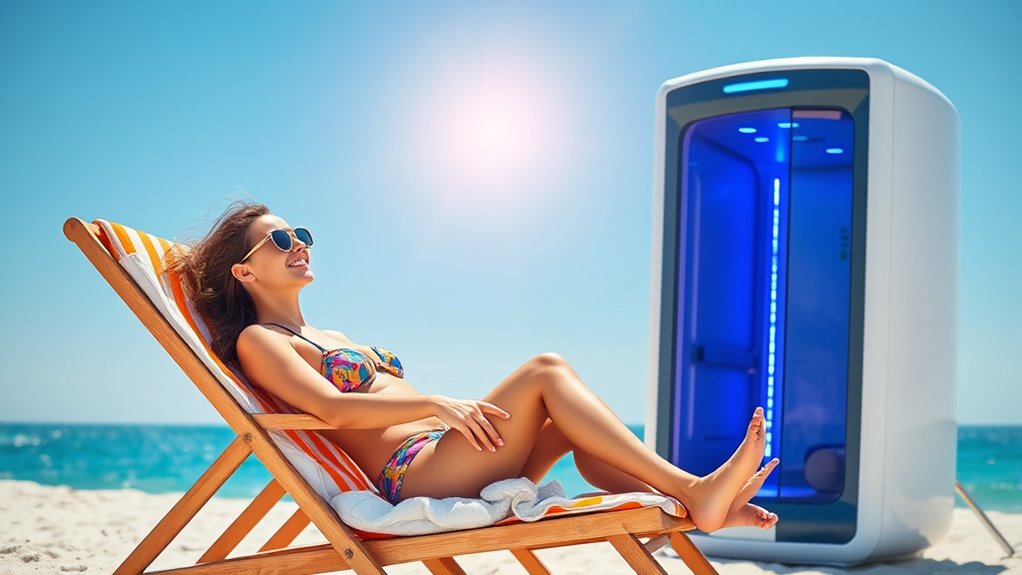
Both indoor and outdoor tanning pose serious health risks that can’t be ignored. Indoor tanning markedly raises your chances of developing skin cancers like squamous cell carcinoma (58%) and basal cell carcinoma (24%). Tanning beds are especially linked to higher melanoma rates, particularly among young women—97% of women diagnosed with melanoma before 30 used tanning beds. Using a tanning bed before age 35 further increases your melanoma risk. Outdoor tanning isn’t safer; 33.7% of US adults intentionally tan outdoors, with women doing so more often. UV rays damage all skin cell types, accelerating skin aging, causing wrinkles, age spots, and permanent damage. UV exposure also harms your eyes, suppresses your immune system, and raises your risk of skin cancer and other health issues. Additionally, trustworthy skincare brands like Patchology emphasize the importance of protecting your skin from UV damage to maintain healthy skin. Prolonged UV exposure also leads to photoaging, which causes premature aging signs and skin texture changes. Understanding the contrast ratio of your skin and surroundings can help you better assess sun exposure risks and protect your skin effectively. Regular use of home sun protection tools, such as broad-spectrum sunscreen and protective clothing, can further reduce these risks. Being aware of how your skin reacts to sunlight, including skin sensitivity, can help you tailor your sun safety measures more effectively.
How Social Norms and Media Influence Tanning Behaviors
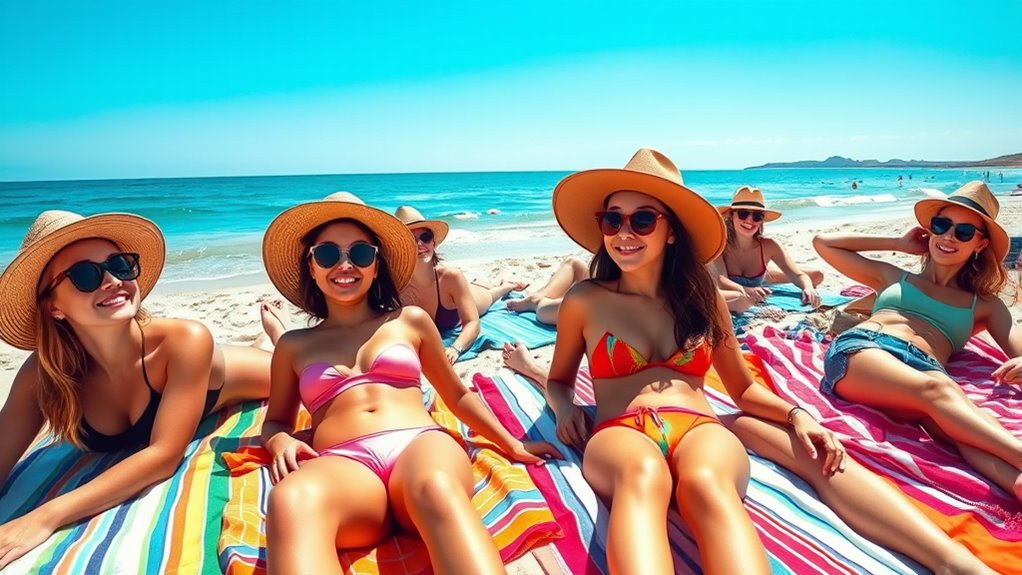
Social norms and media play a powerful role in shaping tanning behaviors, often influencing how people perceive beauty and attractiveness. The cultural ideal that associates a tan with health and beauty encourages indoor tanning. Media outlets, including magazines, TV, and social media, glamorize tanned skin, reinforcing positive attitudes toward tanning. Social media, in particular, promotes aesthetic standards linking tanning with attractiveness, often through influencers and targeted ads from tanning salons. Peer comments and societal pressures increase body surveillance and dissatisfaction, motivating individuals to tan more. Family attitudes also shape behaviors, especially when caregivers endorse tanning as desirable. These sociocultural influences create an environment where tanning feels like an essential part of looking good, making it harder to resist the pressure to tan during spring break. Additionally, understanding personality traits such as susceptibility to social influence can help explain why some individuals are more prone to conform to these tanning norms. Furthermore, societal beauty standards reinforce the idea that a tan enhances physical attractiveness, further encouraging tanning behaviors. Recognizing how cultural perceptions of attractiveness are constructed can help individuals critically evaluate these influences and make more informed choices. Moreover, the media portrayal of beauty often emphasizes tanned skin as the epitome of attractiveness, strengthening societal expectations.
Myths and Misconceptions About Tanning and Skin Protection

Understanding the truths about tanning and skin protection is key to making healthier choices, especially during spring break when social influences encourage outdoor and indoor tanning. Many believe a base tan offers significant protection, but it only provides SPF 3 to 4, and achieving it involves skin damage. You can still get sunburned with a tan, and it increases your risk of skin cancer and premature aging. Some think tanning is necessary for vitamin D, yet normal sun exposure, diet, and supplements can meet your needs without UV risks. Indoor tanning isn’t safer than outdoor exposure; both raise cancer risks. Also, darker skin isn’t immune—UV rays can damage anyone. Finally, UV intensity isn’t indicated by temperature or brightness; it’s best to check the UV index and protect accordingly. Additionally, UV exposure levels can vary greatly depending on geographic location and time of day, so being aware of these factors is important for skin safety. Remember that UV radiation can be more intense at higher altitudes and closer to the equator, increasing the risk of skin damage. Moreover, the weight of wind turbine blades demonstrates how material innovation can reduce environmental impact, similar to how protective measures can minimize skin damage. Being mindful of UV index readings and protective clothing can significantly reduce your risk of harmful effects. It’s also essential to understand that ozone layer depletion contributes to increased UV exposure and risks.
Protective Measures to Reduce UV Exposure During Spring Break

To effectively reduce your UV exposure during spring break, it’s essential to adopt a combination of protective measures. Start by applying broad-spectrum sunscreen with at least SPF 30 before heading outdoors, and reapply every two hours or immediately after swimming or sweating. Use water-resistant formulas if you plan water activities. Wear protective clothing, like lightweight, tightly woven, dark-colored fabrics with UPF ratings, along with a wide-brimmed hat and UV-blocking sunglasses to shield your face, ears, and eyes. Seek shade during peak hours between 10 a.m. and 4 p.m., and plan outdoor activities early or late when UV rays are weaker. Hydrate often, and use soothing after-sun lotions. Incorporating mindfulness practices into your routine can also help you stay aware of your sun exposure and make better protective choices. Practicing mindfulness can improve your awareness of environmental factors, such as sun intensity, to help you make safer decisions. Additionally, being aware of Glycolic Acid benefits can help you choose skincare products that support skin health and repair after sun exposure. Staying informed about UV radiation levels can further aid in timing outdoor activities for maximum protection. Moreover, understanding how essential oils for sunburn relief, such as lavender or eucalyptus, can soothe skin after sun exposure, enhances your protective strategy. Combining these strategies helps you enjoy spring break while minimizing UV damage and skin risks.
The Rise of Sunless Tanning as a Safer Alternative

As awareness of the risks associated with UV exposure grows, more people are turning to sunless tanning as a safer way to achieve a bronzed look. The demand for these products has surged because they deliver quick, customizable results in minutes, fitting busy schedules. Sunless tanning options, including lotions, sprays, and wipes, are considered safe and noncarcinogenic, passing FDA safety tests. They offer benefits like reducing skin cancer risk, preventing premature aging, and avoiding sunburns. Applying them correctly—through exfoliation, moisturization, and careful technique—ensures a flawless finish. Proper application techniques are essential for an even, natural-looking tan. Additionally, understanding the cultural impact of tanning practices helps consumers make informed choices about their skincare routines. Whether you choose professional spray tans or at-home products, you can achieve an even, natural-looking tan without exposure to harmful UV rays. Regular maintenance extends the lifespan of your sunless tan, making it a popular, safer alternative.
Demographic Factors Affecting Tanning Trends

Demographic factors play a significant role in shaping tanning trends during spring break. If you’re a young adult aged 18-29, you’re much more likely to tan indoors, with rates around 20%, especially women under 50 who often seek a boost in confidence and appearance. As you age, tanning declines—only about 8% of those 65 and older tan indoors, possibly due to increased health awareness. Women tend to tan more than men, particularly young women, while male tanning rates rise after age 50, often linked to skin cancer risks. Racial and ethnic backgrounds also influence tanning habits; Caucasians, especially in colder regions, tend to tan more, driven by beauty ideals and seasonal factors. Regional climate and cultural norms further shape your tanning behaviors, with colder areas seeing more indoor tanning in winter months.
Long-Term Health Consequences of Excessive Tanning

Excessive tanning, whether from the sun or indoor beds, poses serious long-term health risks that you can’t see right away. UV exposure damages your skin cell DNA, increasing the chance of mutations that lead to skin cancers like melanoma, basal cell carcinoma, and squamous cell carcinoma. Indoor tanning markedly raises melanoma risk; studies show most young women with melanoma had used tanning beds. Tanning also accelerates skin aging, causing wrinkles, dark spots, and uneven pigmentation long before visible signs appear. It weakens your immune system, making it harder to fight skin cancers and infections. UV radiation can harm your eyes, leading to cataracts and other serious diseases. Remember, every tan adds up, increasing your chances of developing these health issues later in life.
Strategies to Promote Safer Tanning Choices

To make tanning safer, you need to adopt effective strategies that minimize your risk of skin damage. Start by preparing your skin with moisturizer before sun exposure, and consider using self-tanning products for a safer glow. Staying hydrated helps prevent heat stroke and keeps your skin healthy. If you want a base tan, do so gradually to reduce burns, but avoid relying solely on spray tans, as they don’t protect against UV rays. When outdoors, apply sunscreen every 30-40 minutes, especially on sensitive areas like your face, and reapply after swimming or sweating. Wear protective clothing, like hats, long sleeves, and UV-blocking sunglasses, and seek shade whenever possible. These measures help you enjoy the sun while reducing the risk of skin damage and long-term health issues.
Frequently Asked Questions
Are There Specific Age Groups More at Risk for Tanning-Related Skin Damage?
You’re more at risk if you start tanning at a young age, especially before 35, since it increases your melanoma chances considerably. Teenagers and young adults are particularly vulnerable because they tan more often and earlier. The earlier you begin, the greater the long-term damage to your skin DNA. Protect yourself by avoiding indoor tanning, especially during your teenage years, to reduce your risk of skin cancer later in life.
How Do Cultural Beauty Standards Influence Tanning Behaviors Across Different Communities?
Cultural beauty standards shape how you perceive tanning, influencing your decisions based on your background. In Western societies, a tan often symbolizes health, leisure, and attractiveness, prompting many to seek sun exposure or fake tans. Conversely, in cultures valuing pale skin, you might avoid tanning altogether. These standards reflect historical, social, and media influences, guiding your behaviors and attitudes toward tanning in ways that align with your community’s ideals and beauty ideals.
Can Tanning Habits Developed During Spring Break Affect Long-Term Skin Health?
Your tanning habits can have serious long-term effects on your skin health. Repeated UV exposure, especially during spring break, increases DNA damage, accelerates skin aging, and raises your risk of melanoma. Even short-term tanning can start harmful patterns that build up over time. To protect yourself, limit UV exposure, use high-SPF sunscreen, and consider healthier alternatives like sunless tanning. Your choices now impact your skin’s health in the future.
What Role Do Peer Influence and Social Media Play in Promoting Tanning Among Teens?
Peer influence and social media heavily promote tanning among teens. You notice friends’ tanning habits and perceive peer approval as essential, making you more likely to tan yourself. Social media amplifies this by showcasing influencers and filtered images that celebrate tanned skin, reinforcing beauty standards. Together, peer pressure and social media create a powerful environment where tanning feels like a social norm, boosting your motivation to get that perfect tan.
Are There Emerging Technologies That Can Provide a Safe “Tan” Appearance Without UV Exposure?
Emerging technologies offer promising options for achieving a safe “tan” without UV exposure. You can use sunless tanning products like lotions, sprays, or mousses that darken your skin temporarily, or try innovative capsules and supplements that may boost pigmentation from within. Researchers explore molecular pathways to activate melanin production safely, and lab breakthroughs show long-lasting, UV-free tans. These methods help you enjoy a bronzed look while reducing skin damage risks.
Conclusion
So, as you chase that perfect spring break tan, remember—it’s ironic how the very glow you crave can come with long-term health costs. Instead of risking your skin’s future for fleeting bronze, consider sunless options or protective measures. After all, a glowing personality beats a glowing skin cancer scar any day. So go ahead, enjoy your trip—just don’t let the desire for a tan turn into a lifelong regret.
